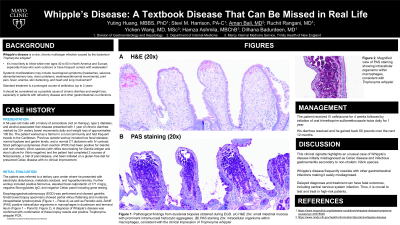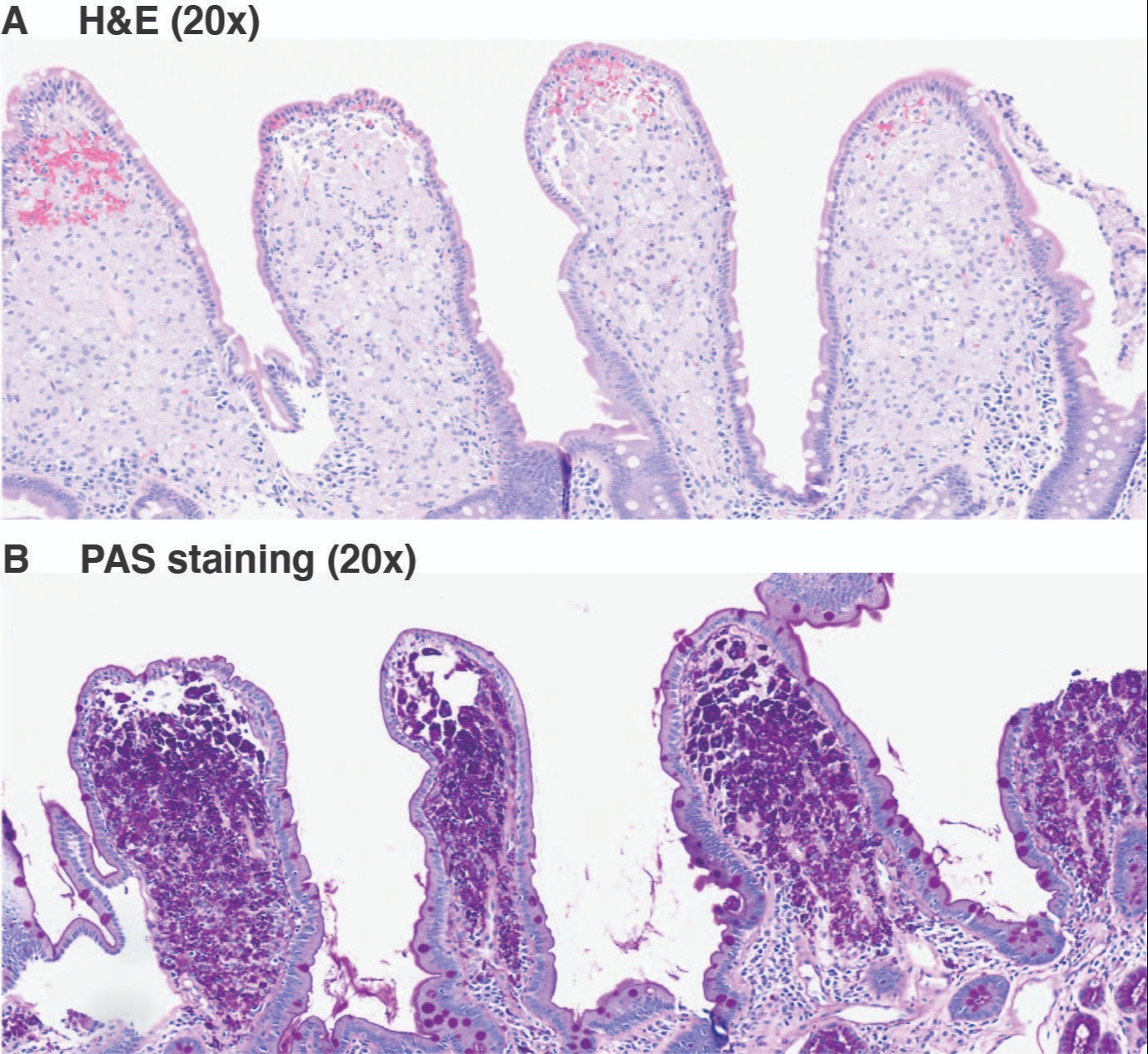Monday Poster Session
Category: Small Intestine
P2662 - Whipple’s Disease: A Textbook Disease That Can Be Missed in Real Life
Monday, October 23, 2023
10:30 AM - 4:15 PM PT
Location: Exhibit Hall

.jpg)
Yuting Huang, MBBS, PhD
Mayo Clinic Florida
Jacksonville, FL
Presenting Author(s)
Yuting Huang, MBBS, PhD1, Stevi M.. Harrison, PA-C2, Aman Bali, MD1, Ruchit Rangani, MD1, Yichen Wang, MD, MSc3, Hamza Ashmila, MBChB1, Wendelyn Bosch, MD1, Dilhana Badurdeen, MD1
1Mayo Clinic Florida, Jacksonville, FL; 2MPAS, PA-C, Jacksonville, FL; 3Mercy Internal Medicine Service, Trinity Health of New England, Springfield, MA
Introduction: Whipple’s disease is a chronic, multiorgan infection caused by the bacterium Tropheryma whipplei. It should be considered as a cause of chronic diarrhea and weight loss, especially in those with refractory disease and other acute gastrointestinal co-infections.
Case Description/Methods: A 54-year-old male with a history of sarcoidosis, type 2 diabetes, and alcoholic liver disease presented with chronic diarrhea and weight loss. The patient had 20+ watery bowel movements daily with about 100 lbs of unintentional weight loss. He is a farmer in a rural community and frequently travels to the Caribbean. Previous workup included low fecal elastase, normal tryptase and gastrin levels and a normal CT abdomen with IV contrast. Stool studies were positive for Giardia and Vibrio. EGD showed gastritis with small bowel biopsies, partial villous flattening, and moderate intraepithelial lymphocytosis. The patient finished 2 courses of Nitazoxanide, trial of pancrelipase, and a gluten-free diet for presumed Celiac disease, but had no clinical improvement.
The patient was referred to a tertiary center, presented with electrolyte disturbance, metabolic acidosis, and hypoalbuminemia. Further workup included positive Norovirus, fecal calprotectin 171 mcg/g, negative Strongyloides IgG, and negative Celiac panel including gene testing. Whipple’s disease was diagnosed with positive Tropheryma whipplei PCR, and endoscopy pathology showed PAS-positive intracellular organisms in macrophages in duodenum and terminal ileum. IV ceftriaxone for 4 weeks followed by oral trimethoprim-sulfamethoxazole bid for 1 year was initiated. The patient’s diarrhea resolved and his weight improved.
Discussion: Whipple's disease, an extremely rare condition affecting fewer than 1 in 1 million people, is most commonly seen in middle-aged white men in North America and Europe who work closely with soil, sewage, and wastewater. The disease can coexist with other gastrointestinal infections, like Giardia, Vibrio, and Novovirus, and its histological findings can resemble those of Celiac disease. Consequently, Whipple's disease can be easily misdiagnosed.
However, delayed diagnoses and treatment can have severe consequences, including fatal outcomes, as the infection can spread to the central nervous system and cause irreversible damage. This can be prevented through readily available treatments such as penicillin or ceftriaxone followed by trimethoprim-sulfamethoxazole. Therefore, it is crucial to conduct prompt testing in high-risk patients.

Disclosures:
Yuting Huang, MBBS, PhD1, Stevi M.. Harrison, PA-C2, Aman Bali, MD1, Ruchit Rangani, MD1, Yichen Wang, MD, MSc3, Hamza Ashmila, MBChB1, Wendelyn Bosch, MD1, Dilhana Badurdeen, MD1. P2662 - Whipple’s Disease: A Textbook Disease That Can Be Missed in Real Life, ACG 2023 Annual Scientific Meeting Abstracts. Vancouver, BC, Canada: American College of Gastroenterology.
1Mayo Clinic Florida, Jacksonville, FL; 2MPAS, PA-C, Jacksonville, FL; 3Mercy Internal Medicine Service, Trinity Health of New England, Springfield, MA
Introduction: Whipple’s disease is a chronic, multiorgan infection caused by the bacterium Tropheryma whipplei. It should be considered as a cause of chronic diarrhea and weight loss, especially in those with refractory disease and other acute gastrointestinal co-infections.
Case Description/Methods: A 54-year-old male with a history of sarcoidosis, type 2 diabetes, and alcoholic liver disease presented with chronic diarrhea and weight loss. The patient had 20+ watery bowel movements daily with about 100 lbs of unintentional weight loss. He is a farmer in a rural community and frequently travels to the Caribbean. Previous workup included low fecal elastase, normal tryptase and gastrin levels and a normal CT abdomen with IV contrast. Stool studies were positive for Giardia and Vibrio. EGD showed gastritis with small bowel biopsies, partial villous flattening, and moderate intraepithelial lymphocytosis. The patient finished 2 courses of Nitazoxanide, trial of pancrelipase, and a gluten-free diet for presumed Celiac disease, but had no clinical improvement.
The patient was referred to a tertiary center, presented with electrolyte disturbance, metabolic acidosis, and hypoalbuminemia. Further workup included positive Norovirus, fecal calprotectin 171 mcg/g, negative Strongyloides IgG, and negative Celiac panel including gene testing. Whipple’s disease was diagnosed with positive Tropheryma whipplei PCR, and endoscopy pathology showed PAS-positive intracellular organisms in macrophages in duodenum and terminal ileum. IV ceftriaxone for 4 weeks followed by oral trimethoprim-sulfamethoxazole bid for 1 year was initiated. The patient’s diarrhea resolved and his weight improved.
Discussion: Whipple's disease, an extremely rare condition affecting fewer than 1 in 1 million people, is most commonly seen in middle-aged white men in North America and Europe who work closely with soil, sewage, and wastewater. The disease can coexist with other gastrointestinal infections, like Giardia, Vibrio, and Novovirus, and its histological findings can resemble those of Celiac disease. Consequently, Whipple's disease can be easily misdiagnosed.
However, delayed diagnoses and treatment can have severe consequences, including fatal outcomes, as the infection can spread to the central nervous system and cause irreversible damage. This can be prevented through readily available treatments such as penicillin or ceftriaxone followed by trimethoprim-sulfamethoxazole. Therefore, it is crucial to conduct prompt testing in high-risk patients.

Figure: Figure. Pathological findings from duodenal biopsies obtained during Esophagogastroduodenoscopy. (A) H&E 20x: Small intestinal mucosa with prominent intramucosal histiocytic aggregates. (B) PAS staining 20x: Intracellular organisms within macrophages, consistent with the clinical impression of Tropheryma whipplei.
Disclosures:
Yuting Huang indicated no relevant financial relationships.
Stevi Harrison indicated no relevant financial relationships.
Aman Bali indicated no relevant financial relationships.
Ruchit Rangani indicated no relevant financial relationships.
Yichen Wang indicated no relevant financial relationships.
Hamza Ashmila indicated no relevant financial relationships.
Wendelyn Bosch indicated no relevant financial relationships.
Dilhana Badurdeen indicated no relevant financial relationships.
Yuting Huang, MBBS, PhD1, Stevi M.. Harrison, PA-C2, Aman Bali, MD1, Ruchit Rangani, MD1, Yichen Wang, MD, MSc3, Hamza Ashmila, MBChB1, Wendelyn Bosch, MD1, Dilhana Badurdeen, MD1. P2662 - Whipple’s Disease: A Textbook Disease That Can Be Missed in Real Life, ACG 2023 Annual Scientific Meeting Abstracts. Vancouver, BC, Canada: American College of Gastroenterology.
